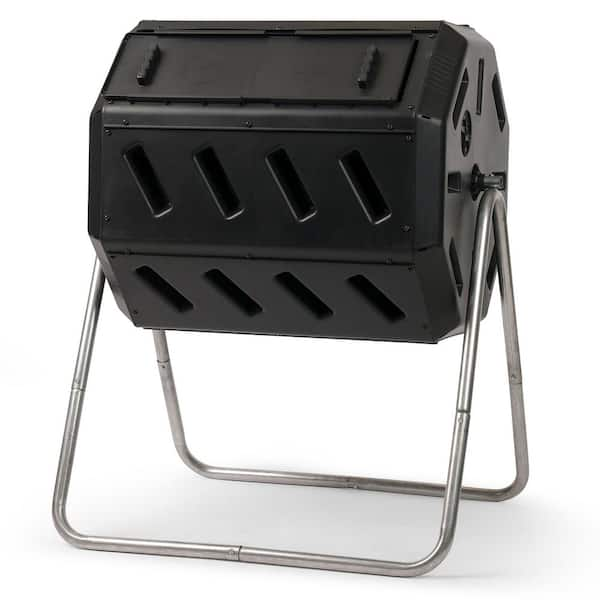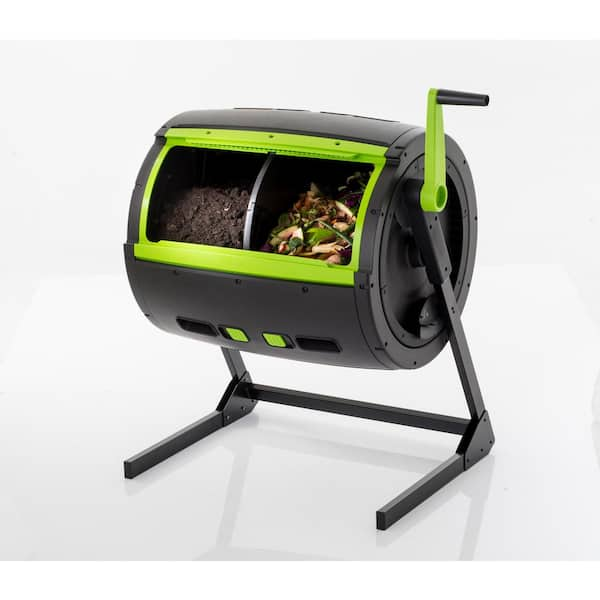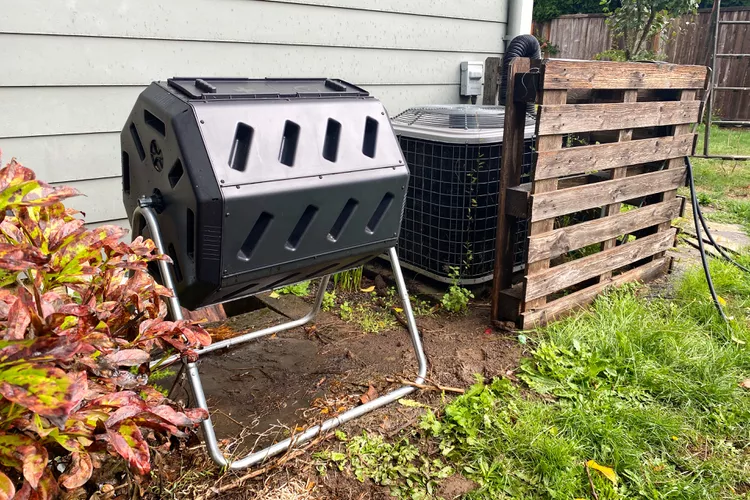A composter is a tool or container used for turning organic waste into nutrient-rich soil. It accelerates the natural decomposition process.
Composting is a sustainable practice that reduces landfill waste while creating fertile soil for gardening and farming. By managing a balance of green and brown organic materials in a composter, microorganisms break down the matter to produce compost. This process not only enriches the soil, aiding in plant growth, but also helps retain moisture and suppresses plant diseases and pests.
Utilizing a composter supports a closed-loop system, turning kitchen scraps and yard waste back into valuable resources for your garden, promoting a healthier environment. Composters come in various sizes and styles, catering to different needs, from a small urban garden to a large rural farm. Implementing a composter is an excellent step toward eco-friendly living and responsible waste management.
Types Of Composters
Introduction to Types of Composters
Turning kitchen scraps and yard waste into garden gold is easy with the right composter. Whether you’re a beginner or a seasoned green thumb, discovering the composter that fits your lifestyle is key. Let’s dig into the different types that turn waste into treasure.Bin Composter
Bin Composter
Bin composters are the champions of stationary composting systems. Think of a large container where organic waste breaks down over time. Bin composters typically sit directly on the ground.
- Easy to use – Just add scraps and let nature do its work.
- Varied styles – Comes in different sizes to fit any garden.
- DIY friendly – You can build one using spare wood or a plastic bin.
Tumbler Composter
Tumbler Composter
A tumbler composter is like a large barrel that you rotate. This mixes the compost, speeding up the process.
- Fast results – Get compost quicker than with a bin.
- No turning by hand – Just spin the barrel.
- Contained unit – Helps keep pests away.
Vermicomposter
Vermicomposter
Vermicomposting relies on worms to break down organic matter. It’s fascinating and efficient, using red wigglers to create nutrient-rich compost.
- Indoor friendly – Perfect for apartments or small spaces.
- Odorless – If managed right, you won’t smell a thing.
- Worm magic – Worms do the work, creating high-quality compost.

Visit AMAZON to know more details.
Key Factors For Effective Composting
Turning kitchen scraps and yard waste into nutrient-rich soil is magic. Effective composting turns “waste” into garden gold. Find out the key factors for effective composting to nurture plants and reduce waste.
Balance Of Green And Brown Materials
- Green materials provide nitrogen. Think veggie scraps and coffee grounds.
- Brown materials add carbon. Examples include leaves and cardboard.
A good mix is one part green to three parts brown. This balance keeps compost healthy and smelling fresh.
Proper Aeration
Oxygen is vital for compost critters. They help break down materials. Turn your pile every few weeks. This ensures oxygen throughout.
Moisture Levels
Your compost pile should feel like a wrung-out sponge. Too dry, and decomposition slows. Too wet, and it may smell. Check moisture often and adjust as needed.
| Condition | Action Needed |
|---|---|
| Dry and dusty | Add water, mix well |
| Too soggy | Mix in more browns |
Benefits Of Composting
Composting transforms kitchen and yard waste into a valuable asset for any garden or lawn. Not only does it offer a way to reduce trash, but it also enhances soil health and supports the environment. Let’s dig into the fascinating benefits of composting!
Reduction Of Waste Sent To Landfills
Composting significantly cuts down on household waste. Food scraps and yard clippings often end up in trash bins. They go to landfills, where they take up space and emit methane, a harmful greenhouse gas. By composting, individuals can turn that waste into something useful rather than filling up landfills.
Nutrient-rich Soil Amendment
Compost works wonders for the soil. It’s like a vitamin boost for your garden that helps plants thrive. Compost adds essential nutrients back into the soil, improving plant growth and health. Also, it enhances soil structure, aeration, and water retention.
- Improves soil fertility
- Increases microbial activity
- Better root development
Environmental Benefits
Composting is an all-star for the environment. It reduces greenhouse gas emissions by keeping organic waste out of landfills. This process prevents methane release, which is critical for combating climate change. Additionally, composting helps conserve water and deters plant diseases, making gardens not just greener but also more eco-friendly.
| Environmental Impact | Impact Reduction |
|---|---|
| Greenhouse Gases | Lower Methane Emissions |
| Water Use | Improved Retention in Soil |
| Plant Diseases | Decreased Occurrence |

Credit: www.amazon.com
Setting Up A Composter
Welcome to the essential guide for setting up your very own home composter! Home composting is a fantastic way to reduce waste and enhance your garden’s soil quality. Let’s start turning your kitchen scraps and yard waste into valuable compost!
Choosing A Location
Before assembling your composter, finding the perfect spot is crucial. Select a place that’s:
- Flat and well-drained: to prevent water pooling.
- Partially shaded: to keep it from drying out.
- Accessible year-round: for easy adding and harvesting.
- Away from water sources: to avoid contamination.
Safety tip: Ensure you place the composter away from your home to avoid unwanted smells and pests.
Assembling The Composter
Ready to build? Follow the instructions provided with your composter kit. For DIY enthusiasts, repurpose materials like wooden pallets or bins. Secure all parts firmly to create a stable composting environment.
- Layout all pieces according to the manual.
- Connect the sides to form the base structure.
- Attach the lid or cover for a finished look.
Remember to wear gloves to protect your hands during assembly.
Adding Composting Materials
Time to kick-start the composting process by adding materials in layers:
| Green Materials | Brown Materials |
|---|---|
| Fruit and vegetable scraps | Dry leaves |
| Coffee grounds | Cardboard |
| Eggshells | Twigs |
Maintain a balance of green and brown materials for efficient decomposition. Stir your pile every few weeks to speed up the composting process.
Maintaining The Composter
To ensure your compost thrives, regular maintenance is a must. Maintaining a composter is like tending a garden. It requires care, attention, and a bit of know-how. The compost process flourishes with a balance of green and brown materials. Still, its success hinges on three crucial factors: turning the pile, monitoring temperature, and managing odor.
Turning The Compost Pile
Stirring the compost mix is essential. It speeds up decomposition and adds oxygen. Aim to turn the pile every week or two. This task prevents material from matting down and forming an anoxic layer.
Monitoring Temperature
Heat is a sign of active decomposition. A healthy composter should feel warm in the center. Use a compost thermometer to check. Temperatures between 130-150°F (55-65°C) indicate ideal conditions. Below 100°F? Add more greens. Above 160°F? Turn it to cool down.
Managing Odor
A foul smell means action is needed. Too much moisture or not enough air often causes bad odors. Adjust by adding dry brown materials and turning more frequently. Always cover fresh food scraps with browns to help control smells.
| Issue | Action |
|---|---|
| Smelly Compost | Add brown materials, turn pile |
| Low Temperature | Add green materials |
| High Temperature | Turn to cool down |
Regular maintenance keeps your compost healthy. Stick to these practices and watch as your kitchen scraps and yard waste turn into nutrient-rich soil!

Credit: www.homedepot.com
Composting Troubleshooting
Enticing the beauty of nature into our backyards, composting stands as a cornerstone of sustainable living. But just like any garden endeavor, it can encounter a few hiccups. Troubleshooting common composting problems ensures a healthier, happier compost pile. Let’s dig in to solve some common issues.
Compost Too Wet Or Too Dry
Is your compost looking more like a swamp or a desert? Balance is key.
- Add brown materials like dry leaves or shredded newspaper to sop up excess moisture.
- Decrease green materials if your pile is too wet; these include kitchen scraps and fresh grass clippings.
- Introduce more green materials or water lightly if the compost is too dry.
- Turn your compost to help air it out or distribute moisture evenly.
Compost Not Heating Up
A cold compost pile can be quite stubborn, not breaking down as it should.
- Ensure a balance of 1-part green to 3-parts brown materials.
- Turn your pile to add oxygen, which bacteria need to thrive.
- Check the pile’s moisture; it should feel like a wrung-out sponge.
- Scale up your pile; a small pile might not hold heat well.
Pests In The Composter
Unwanted guests can turn a compost pile into a pest playground.
- Cover food scraps with brown material to mask the inviting smells.
- Keep a tight lid on your compost bin if it has one.
- Avoid adding meats, dairy, or oily foods that draw critters.
- Ensure your compost pile is well-maintained with regular turning, which can discourage pests.
Harvesting And Using Compost
The art of creating rich compost doesn’t end when your scraps and yard waste transform into dark, crumbly matter. In fact, harvesting and using compost is a thrilling stage. It means your efforts in eco-friendly waste management are about to pay off immensely.
Signs Of Ready Compost
To know when compost is ready to use, look for specific signs:
- Dark, rich color similar to potting soil
- Crumbly texture that holds together lightly
- A pleasant, earthy smell without any foul odor
- No recognizable food or yard waste within the material
Methods For Harvesting Compost
- Allow the compost to sit for a couple of weeks.
- Remove the top layer which isn’t fully broken down.
- Scoop out the finished compost from the bottom.
- Use a sieve or screen to filter out large particles.
- Return any uncomposted material to the composter for further breakdown.
Ways To Use Compost
Once harvested, compost is incredibly versatile:
| Use | Method |
|---|---|
| Garden soil amendment | Mix with soil before planting |
| Lawn top dressing | Spread thinly over grass |
| Potting mix | Combine with soil and sand for pots |
| Mulch | Layer on soil surface to preserve moisture |
| Compost tea | Steep in water and use as liquid fertilizer |
Rich compost can boost your plants’ health, improve soil structure, and even suppress plant diseases. Embracing compost use means taking part in a sustainable cycle that benefits both your garden and the planet.
Innovations In Composting
Imagine turning kitchen scraps into garden gold with the latest innovations in composting. These breakthroughs not only enrich soil but also reduce waste in novel, efficient ways.
High-tech Composters
Modern technology reshapes composting, making it faster and more convenient. High-tech composters come with features that control temperature, moisture, and aeration. This precision accelerates the decomposition process, transforming leftovers into nourishing soil additives in record time.
- Odor filters ensure indoor composting remains a fresh experience.
- Electric models offer quiet operation while saving space.
- Monitor progress with smartphone apps, tailoring the process to your needs.
Community Composting Programs
Community composting programs take waste reduction to the next level. They support local gardens, reduce landfill use, and foster environmental stewardship. Members contribute organic waste and share in the resulting compost, enhancing local greenery.
- Gather neighbors together to start a collective composting initiative.
- Share resources and knowledge to make composting accessible to all.
- Contribute to greener communities through joint waste-reduction efforts.
Frequently Asked Questions
Are Compost Bins Worth It?
Compost bins effectively reduce waste and enrich soil health, offering an eco-friendly option for recycling kitchen scraps and yard debris. They are a cost-effective investment for gardeners seeking sustainable practices.
What Does A Composter Do?
A composter decomposes organic waste into nutrient-rich soil, known as compost, through a natural process involving microorganisms.
How Do You Make A Homemade Composter?
Select a suitable container or bin. Drill holes for air and drainage. Layer greens (kitchen scraps) and browns (dry leaves). Turn regularly to aerate. Keep moist for efficient decomposition.
How Long Does It Take For A Compost Bin To Decompose?
The decomposition time for a compost bin typically ranges from 3 to 6 months, depending on factors like material balance, temperature, and turning frequency.
What Is A Composter Used For?
A composter is used to break down organic waste into nutrient-rich compost for gardening.
Conclusion
Embracing composting benefits both your garden and the environment. With a composter, you enrich the soil, reduce waste, and limit chemical use. Start this sustainable practice and witness nature’s remarkable transformation. Be the change, one heap at a time. Your greener footprint begins in your own backyard.


1 Comment